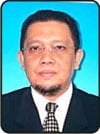The Utilization of Information and Communication Technology among Islamic Secondary School Teachers in Malaysia
Abstract
ABSTRACT: Malaysia has implemented the first computer system in 1966. Since then, the government — through Ministry of Education — has introduced various initiatives to facilitate the adoption and diffusion of Information and Communication Technology (ICT). In line with the Vision 2020, Ministry of Education has draft ways so as to integrate ICT into education system. Malaysian government has invested millions of Ringgit for the usage of ICT in education. The investments include the building of computer labs, supplying of PCs, and related peripherals, training of teachers, and development of instructional material. The research will concentrate on the utilization, self-efficacy, integration, and satisfactory level of the Islamic Religious Secondary School teachers of Malaysia. Although there are only 55 of such schools but these schools are actually a sought after schools by parents due to its capability of producing leaders academically as well as spiritually. The study will deal with issues such as self-efficacy, utilization, and training needs/provided as well as the integration of ICT in teaching and learning. The analysis is adopting principle component analysis to determine the predictors of the underlying variables as well the use of Structural Equation Modeling (SEM) to strengthen the analysis.
Key words: Information and communication technology, K-economy, teachers of Malaysia, and competences in teaching and learning.

About the Author: Assoc. Prof. Dr. Adnan Abd Rashid is Senior Lecturer at the Institute of Education IIUM (International Islamic University of Malaysia), Jalan Gombak, 53100 Kuala Lumpur, Malaysia. He can be reached at: adnan@iiu.edu.my and arashid@isesco.org.ma
How to cite this article? Rashid, Adnan Abd. (2011). “The Utilization of Information and Communication Technology among Islamic Secondary School Teachers in Malaysia” in SOSIOHUMANIKA: Jurnal Pendidikan Sains Sosial dan Kemanusiaan, Vol.4, No.2 [November], pp.145-158. Bandung, Indonesia: Minda Masagi Press owned by ASPENSI, ISSN 1979-0112.
Chronicle of article: Accepted (September 15, 2011); Revised (October 20, 2011); and Published (November 20, 2011).
Full Text:
PDFReferences
Arbuckle, J. & L. Wothke. (1999). AMOS Users’ Guide Version 4.0. Chicago, IL: Small Waters Corporation.
Arsham, Hossein. (n.d.). Impact of the Internet on Learning and Teaching. Baltimore, USA: The University of Baltimore. Also available at http://ubmail.ubalt.edu/~harsham [accessed in Kuala Lumpur, Malaysia: 9 October 2011].
Cavanagh, R.F., P.S. Reynolds & J.T. Romanoski. (2004). Information and Communication Technology Learning in the Classroom: The Influence of Students, the Class-Group, Teachers, and the Home. Canberra, Australia: Australian Research Council, Curtin University of Technology, Department of Education.
Chan, Foong-Mae. (2002). ICT in Malaysian Schools: Policy and Strategies. Kuala Lumpur, Malaysia: Educational Technology Division, Ministry of Education.
Eisenberg, M.B. & J. Dough. (2002). “Learning and Teaching Information Technology: Computer Skills in Context” in ERIC Digest [On-line].
Marzuki, A.M. et al. (2005). Faculty’s Satisfaction and Sense of Efficacy in the Use of Information Technology. Kuala Lumpur, Malaysia: IUUM [International Islamic University of Malaysia].
Mumtaz, S. (2000). “Factors Affecting Teachers’ Use of Information and Communication Technology: A Review of Literature” in Journal of Information Technology for Teacher Education, 9(3), pp.319-341.
Rigdon, E.E. (1996). “CFI Versus RMSEA: A Comparison for Two Fit Indices for Structural Equation Modeling” in Journal of Information Technology for Teacher Education, 3(4), pp.369-379.
Schrum, Lynne, Mary D. Burbank & Rosemary Capps. (2007). “Preparing Future Teachers for Diverse Schools in an Online Learning Community: Perceptions and Practice” in The Internet and Higher Education, 10, pp.204-211.
Shelly, Gary B., J.C. Thomas & E.V. Misty. (2007). Discovering Computers 2007: A Gateway to Information. New York, USA: Thomson Course Technology.
SOSIOHUMANIKA: Jurnal Pendidikan Sains Sosial dan Kemanusiaan is published by Minda Masagi Press. This work is licensed under a Creative Commons Attribution-Sharealike 4.0.
